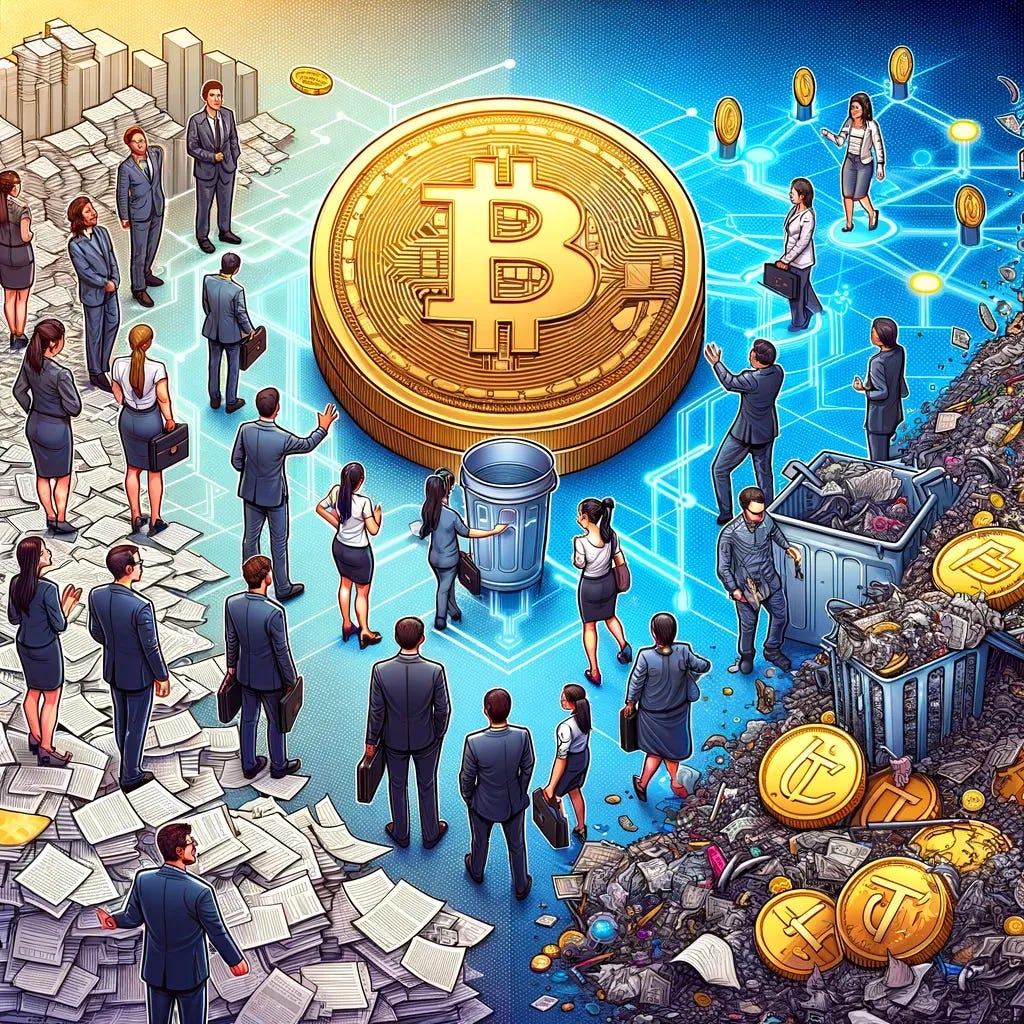In almost 100% of cases, deploying your token is a mistake
Discover essential insights : 10 Tips from a Tokenomist for Blockchain Builders 🚀💡
Today's agenda...
Dive into the intricate world of tokenomics with expert advice, differentiating between tokenomics and token design, and navigating the dos and don'ts of token deployment. 🚀💰
Gain valuable insights into web3 People Ops as an expert shares tips on seamless offboarding processes, including discussions with departing employees, offboarding interviews, and adding a festive touch to farewells. 🗣️🎉
10 Tips from a tokenomist to blockchain project creators
This article was written by our partner Supra Futura, and you can find their presentation following this section.
1/ Tokenomics ≠ Token-design.
Tokenomics is the field that deals with creating economic models that function on the blockchain and utilize crypto-assets.
Having no token doesn't mean you don't need a tokenomist ; on the contrary. The tokenomist plays a crucial role, helping create a model consistent with blockchain's unique characteristics, whether a token is involved or not. 🎨💹
2/ It's better to start with a centralized project moving toward decentralization than the other way around.
Creating a complex, decentralized system from the start is challenging. Starting with a centralized project and decentralizing gradually requires extra effort in roadmap design but allows more freedom to learn and iterate before taking a big leap.
We often recommend Proof of Concept (POC) or Minimum Viable Product (MVP) phases, where blockchain's role is minimal to validate the market. 🔄📈
3/ In almost 100% of cases, deploying your token is a mistake.
For projects led by an established entity (with legal responsibility), token deployment is highly costly, averaging over €150k in deployment costs, mainly legal. Market entry is also expensive, especially when planning to use decentralized liquidity pools, which consume capital.
Today, we often encounter projects with "trash tokens," deployed for funding but becoming more of a cost than an opportunity. Launching a token later is better than dealing with a poorly distributed token. Out of 15 projects we've assisted in the last 2 years, only 2 will deploy a proprietary token. 💰💡
4/ The framing stage is essential before embarking on any blockchain design process.
This involves:
Defining the organizational model: Do we need a legally established structure? What will be its form and function? Do we need a DAO-like structure?
Defining the functional scope of the application or ecosystem. At this stage, it's unnecessary to detail each feature but to have an overview of the system's major features.
Conducting market research, crucial in web3. Blockchain introduces new user behaviors and frictions. Ensure future users are inclined to adopt your system, especially in B2B segments. Analyze competitors, both indirect web2 and direct blockchain, focusing on legal aspects in the PESTEL analysis, especially if the project involves an established legal structure.
Risk analysis, consolidating a comprehensive risk study and beginning to think about neutralizing these risks. In blockchain, risks abound: legal, economic, technical, and adoption.
Defining a roadmap leading to the MVP. Create separate roadmaps for each domain: technical, marketing, legal, etc., to have clarity in your operational plan.
The last and perhaps most crucial step: defining the V1 of your economic model. For this, we recommend using the Business Model Canvas (BMC) methodology. This initial version will be completed following the tokenomist's work.
5/ Building economic models based on blockchain is a complex art more intricate than in traditional business. The main reason is that in the blockchain, everything is public. It's an open-source world where every on-chain component is instantly and costlessly replicable. Thus, acquiring a competitive advantage through innovation is nearly impossible. Special attention must be given to designing your product and economic strategy. 🎨📊
6/ As a positive consequence of the previous point, don't reinvent the wheel.
The blockchain thrives on composability, with numerous dApps allowing you to create features with minimal effort. Whether you need on-chain voting systems, decentralized data storage (IPFS), communication with NFT-holding community members, or conflict resolution arbitration (Kleros), existing solutions can be readily integrated. 🔄🤖
7/ Tokenization is not the promised land many believe it to be.
Creating an economic model around tokenization requires thoughtful economic structuring to generate profitability. Tokenization is attractive for consumers but economically complex for providers. Not all assets are equal ; for example, creating a viable tokenization model for real estate, especially for smaller players, is challenging. Tokenizing collectibles represents a more interesting market opportunity (e.g., Courtyard). Such projects primarily involve legally structuring processes and finding ways to value NFTs higher than their underlying assets, crucial for profitability. Technical challenges are minimal; it's mostly about the business model and legal compliance. 🏰💸
8/ Issuing NFTs requires careful consideration.
Issuing fixed-supply at fixed prices often lacks logic, despite being the most common mode. Various techniques have developed recently, such as augmented Dutch auctions, bonding curves applied to NFTs, and extensible supplies. 🎨🛍️
9/ While it's beneficial to reuse existing blockchain applications, knowing when to deploy your components is crucial.
For instance, selling NFTs on Opensea is a classic mistake. Developing your decentralized marketplace is as simple as searching "git smart contracts decentralized marketplace" on Google and adapting the code to your needs. This allows you to capture transaction fees, a valuable revenue source in a sensitive blockchain economic model. 💻💲
10/ Don't launch without studying at least a minimum.
Many project creators barely understand what a smart contract is and the implications of blockchain on an economic model. To learn blockchain, studying functioning systems is invaluable. Here's a list of relevant dApps/protocols/projects to study:
Chainlink, for trustless data gathering, random number generation, or on-chain task automation. Their economic model and tokenomics are unique and efficient.
The Graph, for fast and trustless display of blockchain data on user interfaces. Understanding such use cases is essential for decentralized application designers.
Ocean Protocol, for valuing data and creating a new revenue stream. Well-structured tokenomics, sector models, and revolutionary use cases.
Gnosis Safe, for multi-party signature processes, a tool used in almost every project.
Balancer and weighted pools, for deploying liquidity pools with minimal capital.
Courtyard and its highly efficient tokenization model.
Yearn.finance, the best-structured investment DAO in the market.
Stapleverse, the token-gated ecosystem for creators. 🚀📚
Some informations about Supra Futura
The team brings together diverse profiles to guide a project from ideation to development: Alex Jilbert (Product Designer, founder of Art Consortium), Matthieu Quiniou (lawyer at the Paris Bar, lecturer at Paris 8, and founder of Legal Brains), Laura Moretti (Marketing and Growth, COO at Crypto Daily), Cédric Lion (Tokenomics Designer), Thomas Cadorel (Economist and blockchain architect, founder of Supra Futura). Contact them here.
They have supported over 15 projects in the past two years and engage in R&D activities to stay at the forefront of the latest technical and economic advancements, developing their own solutions. 💼🔍
And if you're truly committed to professionalizing, they have launched a dedicated training program for future blockchain project designers. Over 8 weeks, with 2 hours per week, you'll learn essential elements and advanced design techniques.
The next session starts in January; you can enroll here. 🎓✨
Bonus: Some tips for the Blockchain Project Manager
Anticipate your recruitment needs in advance. Good profiles are scarce. If using external providers, ask for references.
Choosing a legal partner is crucial. This partner will play a key role and accompany you for a significant part of your project's life. Many bad lawyers exist; don't go for those making excessive noise and communication—they usually charge a lot for little.
The technical development phase is unique, involving audits and fairly long testing phases. Blockchain technical project management differs significantly from conventional practices. Have an experienced project manager guide you.
Get your technical audits done by DAOs, not specialized companies. You'll save a lot of money, and audit quality is much better when done by a DAO (many options are available based on your needs). You can check :
Prefer an upgradeable and modular architecture over immutable monoliths. Immutability is a problematic concept in blockchain for application scalability. Architecture patterns exist, but few developers are familiar with them. Ensure this is the case, as standard migrations are costly and will handicap the project in the medium to long term. 🏗️💡
Join us on X, Thursday at 5 pm CET for an open room
You're welcome to join as you wish:
with a management challenge you want to solve, 🤔
to help another builder overcome their challenge, 🤝
just as a listener to learn and be inspired. 👂💡
In the reader's words
The tips from a web3 People Ops
Last week, we focused on the subject of contributors’ offboarding. As a complement and reaction to this dossier, Manon Furst, who happens to be one of our readers and kindly shared her insights with us, on how she ideally manages offboardings in early stage projects :
Manon Furst - People Ops & Talent Acquisition in web3 projects
Discussion between employee and their manager: Establish the terms of departure - type of departure (mutual agreement, resignation, dismissal), date (based on the projects the employee was working on). I am more inclined not to keep the employee during the 3-month notice period. Generally, I ask them to finish their project if possible and prepare for handover (in a normal context, the notice period was approximately one month). 🗣️💼🗓️
Announcement to the team: During this discussion, the employee's preferred way of announcing their departure to the team was discussed (stand-up in front of everyone at the same time, one-on-one, to their team first, then the rest). I respected the employees' preferences about how they wanted to depart. 📢👋😊
Offboarding interviews: Once the departure was announced, there were two offboarding interviews. One with the manager, focusing on more specific aspects related to the occupied position, how to improve it, whom to search for, feedback to the manager, etc. Another one with me (talent manager), more on a broader scale, discussing cultural aspects. 📋👥💬
Festive aspect: Then, I organized a more festive aspect:
For everyone, an online collection and card using a tool like : Sharewell.
A farewell dinner paid by the company.🎉🍽️
If you like our work, feel free to like and comment.
Follow us on Linkedin to keep up with all our news.
Disclaimer : The goal of this newsletter is to inform and produce content related to management in the world of Web3. It is not investment advice. Investments in crypto-assets and NFTs are risky and can result in the loss of your entire capital. Always conduct your own research and exercise caution.









👏👏👏